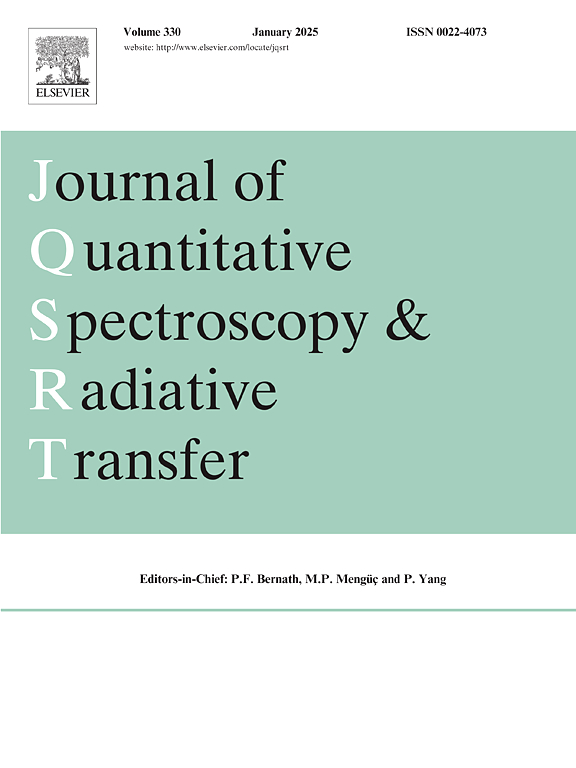Theoretical performance limits of nonreciprocal thermophotovoltaic power generation for deep-space applications
IF 2.3
3区 物理与天体物理
Q2 OPTICS
Journal of Quantitative Spectroscopy & Radiative Transfer
Pub Date : 2025-05-29
DOI:10.1016/j.jqsrt.2025.109542
引用次数: 0
Abstract
Thermophotovoltaic (TPV) systems exhibit potential for generating electrical power in environments where sunlight is unavailable, such as in deep-space missions. However, the performance of conventional TPV systems that use reciprocal emitters and photovoltaic (PV) cells is limited by Kirchhoff’s law, which constrains the radiative exchange between the emitter and absorber. Nonreciprocal materials, which break the symmetry between absorption and emission, have recently been proposed to overcome this limitation and enhance energy transfer efficiency. In this study, we theoretically investigated the performance limits of a nonreciprocal TPV power generation system operating under cryogenic conditions in space environments. Our model comprised a two-layer thermoradiative (TR) emitter at high temperatures and two-layer PV cell at low temperatures, both employing idealized nonreciprocal materials. We derived the optimal operating conditions based on the generalized Planck’s law and calculated the maximum achievable power density and conversion efficiency for both reciprocal and nonreciprocal configurations. The results indicate that introducing nonreciprocity significantly improves the energy transfer between layers and increases the power output, particularly under large temperature differentials. Additionally, we evaluated the effect of multiple-cell stacking and demonstrated that nonreciprocal systems exhibited broader optimal bandgap distributions than their reciprocal counterparts. These findings suggest that nonreciprocal TPV systems offer a viable pathway for efficient power generation in deep-space missions.
深空应用非互易热光伏发电的理论性能极限
热光伏(TPV)系统显示出在没有阳光的环境中发电的潜力,比如在深空任务中。然而,使用互反发射器和光伏(PV)电池的传统TPV系统的性能受到基尔霍夫定律的限制,基尔霍夫定律限制了发射器和吸收器之间的辐射交换。非互易材料打破了吸收和发射之间的对称性,最近被提出来克服这一限制,提高能量传递效率。在这项研究中,我们从理论上研究了在太空环境中低温条件下运行的非互易TPV发电系统的性能极限。我们的模型包括高温下的两层热辐射(TR)发射器和低温下的两层PV电池,两者都采用了理想的非互易材料。基于广义普朗克定律推导出了最优运行条件,并计算了互反和非互反构型下的最大可达功率密度和转换效率。结果表明,引入非互易可以显著改善层间的能量传递,增加功率输出,特别是在大温差下。此外,我们评估了多细胞堆叠的影响,并证明了非互反系统比其互反系统表现出更宽的最佳带隙分布。这些发现表明,非互反TPV系统为在深空任务中高效发电提供了一条可行的途径。
本文章由计算机程序翻译,如有差异,请以英文原文为准。
求助全文
约1分钟内获得全文
求助全文
来源期刊
CiteScore
5.30
自引率
21.70%
发文量
273
审稿时长
58 days
期刊介绍:
Papers with the following subject areas are suitable for publication in the Journal of Quantitative Spectroscopy and Radiative Transfer:
- Theoretical and experimental aspects of the spectra of atoms, molecules, ions, and plasmas.
- Spectral lineshape studies including models and computational algorithms.
- Atmospheric spectroscopy.
- Theoretical and experimental aspects of light scattering.
- Application of light scattering in particle characterization and remote sensing.
- Application of light scattering in biological sciences and medicine.
- Radiative transfer in absorbing, emitting, and scattering media.
- Radiative transfer in stochastic media.

 求助内容:
求助内容: 应助结果提醒方式:
应助结果提醒方式:


